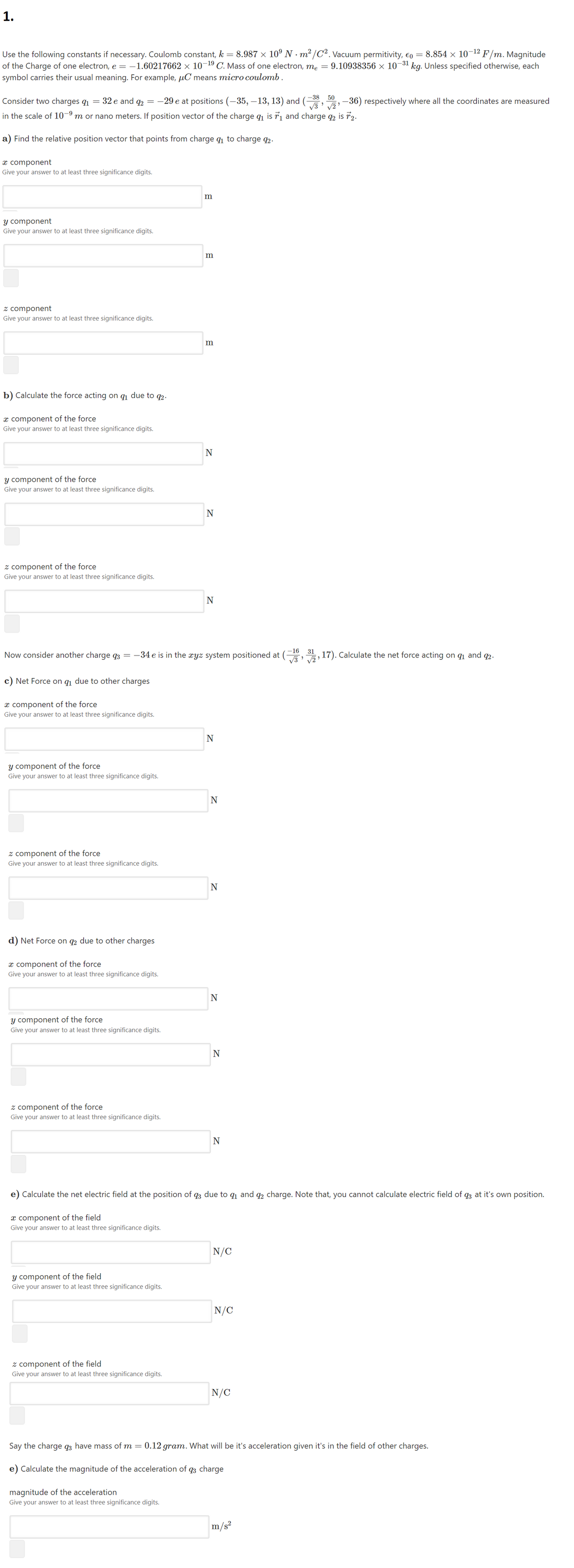-38 50 Consider two charges q1 = 32 e and q2 = -29 e at positions (-35, –13, 13) and ( -36) respectively where all the coordinates are measured in the scale of 10–9 m or nano meters. If position vector of the charge q1 is r1 and charge q2 is r2.
-38 50 Consider two charges q1 = 32 e and q2 = -29 e at positions (-35, –13, 13) and ( -36) respectively where all the coordinates are measured in the scale of 10–9 m or nano meters. If position vector of the charge q1 is r1 and charge q2 is r2.
Principles of Physics: A Calculus-Based Text
5th Edition
ISBN:9781133104261
Author:Raymond A. Serway, John W. Jewett
Publisher:Raymond A. Serway, John W. Jewett
Chapter19: Electric Forces And Electric Fields
Section: Chapter Questions
Problem 3P: Nobel laureate Richard Feynman (19181088) once said that if two persons stood at arms length from...
Related questions
Question
Kindly give me the answers of d, e and e. (I have two e in the question please answer both of them) all the questions are related. Give me the solve squencely with mentioning the numbers.

Transcribed Image Text:8.854 x 10¬12 F/m. Magnitude
Use the following constants if necessary. Coulomb constant, k = 8.987 × 10° N · m² /C2. Vacuum permitivity, €o =
of the Charge of one electron, e = -1.60217662 × 10¬19 C. Mass of one electron, me = 9.10938356 × 10¬31 kg. Unless specified otherwise, each
symbol carries their usual meaning. For example, µC means micro coulomb .
-38
50
Consider two charges q1
= 32 e and q2 =-29 e at positions (-35, –13, 13) and (-
E, -36) respectively where all the coordinates are measured
in the scale of 10-9
m or nano meters. If position vector of the charge q1 is r1 and charge q, is r2.
a) Find the relative position vector that points from charge q1 to charge q2.
x component
Give your answer to at least three significance digits.
m
y component
Give your answer to at least three significance digits.
m
z component
Give your answer to at least three significance digits.
b) Calculate the force acting on q1 due to q2.
x component of the force
Give your answer to at least three significance digits.
y component of the force
Give your answer to at least three significance digits.
N
z component of the force
Give your answer to at least three significance digits.
N
-16
31
Now consider another charge q3 = -34 e is in the xyz system positioned at (-
V3
, 17). Calculate the net force acting on q1 and q2.
c) Net Force on q1 due to other charges
x component of the force
Give your answer
at least three significance digits.
N
y component of the force
Give your answer to at least three significance digits.
z component of the force
Give your answer to at least three significance digits.
d) Net Force on q2 due to other charges
x component of the force
Give your answer to at least three significance digits.
y component of the force
Give your answer to at least three significance digits.
N
z component of the force
Give your answer to at least three significance digits.
N
e) Calculate the net electric field at the position of q3 due to q1 and q2 charge. Note that, you cannot calculate electric field of q3 at it's own position.
x component of the field
Give your answer to at least three significance digits.
N/C
Y component of the field
Give your answer to at least three significance digits.
N/C
z component of the field
Give your answer to at least three significance digits.
N/C
Say the charge q3 have mass of m =
0.12 gram. What will be it's acceleration given it's in the field of other charges.
e) Calculate the magnitude of the acceleration of q3 charge
magnitude of the acceleration
Give your answer to at least three significance digits.
m/s²
1.
Expert Solution
This question has been solved!
Explore an expertly crafted, step-by-step solution for a thorough understanding of key concepts.
Step by step
Solved in 4 steps with 7 images

Knowledge Booster
Learn more about
Need a deep-dive on the concept behind this application? Look no further. Learn more about this topic, physics and related others by exploring similar questions and additional content below.Recommended textbooks for you

Principles of Physics: A Calculus-Based Text
Physics
ISBN:
9781133104261
Author:
Raymond A. Serway, John W. Jewett
Publisher:
Cengage Learning

Physics for Scientists and Engineers with Modern …
Physics
ISBN:
9781337553292
Author:
Raymond A. Serway, John W. Jewett
Publisher:
Cengage Learning

Physics for Scientists and Engineers: Foundations…
Physics
ISBN:
9781133939146
Author:
Katz, Debora M.
Publisher:
Cengage Learning

Principles of Physics: A Calculus-Based Text
Physics
ISBN:
9781133104261
Author:
Raymond A. Serway, John W. Jewett
Publisher:
Cengage Learning

Physics for Scientists and Engineers with Modern …
Physics
ISBN:
9781337553292
Author:
Raymond A. Serway, John W. Jewett
Publisher:
Cengage Learning

Physics for Scientists and Engineers: Foundations…
Physics
ISBN:
9781133939146
Author:
Katz, Debora M.
Publisher:
Cengage Learning

College Physics
Physics
ISBN:
9781938168000
Author:
Paul Peter Urone, Roger Hinrichs
Publisher:
OpenStax College